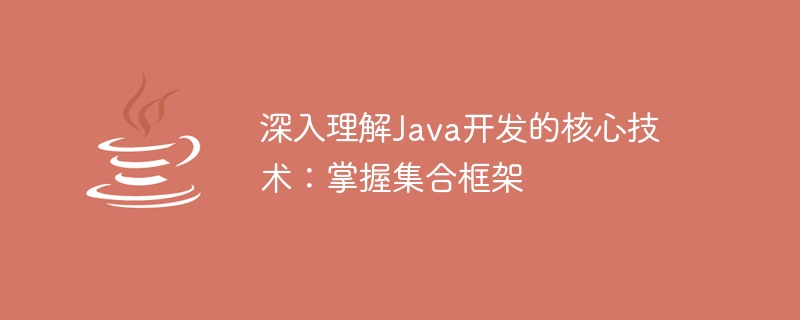

In modern software development, Java has become one of the most popular programming languages. As an object-oriented language, Java has a rich application field, from desktop applications to mobile applications to back-end services, everywhere.
In Java development, mastering the collection framework is a very important core technology. The collection framework provides a series of data structures and algorithms to facilitate developers to process and operate data. It is not only a data container, but also a toolkit for processing data.
Java's collection framework can be divided into three parts: Collection interface, Map interface and Iterator interface. The Collection interface is the most basic interface, which defines a set of common methods for operating elements in a collection. The Map interface is a mapping table of key-value pairs, used to store one-to-one relationships. The Iterator interface provides a way to traverse the elements of a collection and access each element in the collection in turn.
In Java's collection framework, the most commonly used collection classes include ArrayList, HashSet, LinkedList, and TreeSet. ArrayList is a dynamically expandable collection class based on arrays, suitable for scenarios that require frequent access to elements. HashSet is an unordered set class implemented based on hash tables, suitable for scenarios that require fast search and deduplication. LinkedList is a collection class based on linked list, suitable for scenarios where elements need to be frequently inserted and deleted. TreeSet is an ordered collection class implemented based on red-black trees, which is suitable for scenarios where elements need to be sorted in a certain way.
In addition to collection classes, Java's collection framework also provides a series of tool classes for operating and processing collections. For example, the Collections class provides some static methods, such as sorting, searching, and filling, etc.; the Arrays class provides some static methods, such as sorting, searching, and converting. These tool classes greatly simplify developers' operations on collections and improve development efficiency.
Mastering the collection framework is not only a basic technology to understand Java, but also the key to improving programming skills. In actual development, almost every application needs to process data, and the collection framework provides an efficient, flexible and scalable way to handle various data structures.
Using the collection framework can greatly simplify the code logic and improve the readability and maintainability of the code. For example, when traversing collection elements, you can use the Iterator interface to traverse without having to worry about the implementation details of the underlying data structure. For another example, when searching for and deleting elements, you can use the methods provided by the Collection interface without manually implementing complex logic.
In addition to basic operations, the collection framework also provides some advanced features and functions. For example, iterators can be used to implement weak references and soft references of collections to solve memory leak problems. For another example, you can use various conversion methods and filters of collections to convert and filter data.
In general, mastering the collection framework is an essential skill in Java development. It not only improves the readability and maintainability of code, but also helps developers solve various complex data processing problems. Only by deeply understanding the design principles and usage of the collection framework can we better apply it to solve actual development problems.
When learning and using the collection framework, it is recommended to consolidate the knowledge learned through practical exercises and project practice. You can try to use different collection classes and tool classes to solve various problems to improve your practical abilities. In addition, you can also expand your knowledge by reading more relevant books and articles, participating in trainings and seminars, etc.
As the most commonly used part of Java programming, the collection framework is designed and implemented with full consideration of the balance of performance and flexibility. Mastering the collection framework allows developers to focus more on the implementation of business logic without caring about the specific implementation of underlying data structures and algorithms. Therefore, strengthening the learning of collection framework is something every Java developer must do.
The above is the detailed content of In-depth study of the key technologies of Java development: mastering the collection framework. For more information, please follow other related articles on the PHP Chinese website!
 The core technologies of the big data analysis system include
The core technologies of the big data analysis system include
 What are the core technologies necessary for Java development?
What are the core technologies necessary for Java development?
 Introduction to java core technology content
Introduction to java core technology content
 Introduction to Kirchhoff's theorem
Introduction to Kirchhoff's theorem
 How to recover completely deleted files on computer
How to recover completely deleted files on computer
 The difference between html and url
The difference between html and url
 attributeusage
attributeusage
 Thunder 7 crack patch
Thunder 7 crack patch




